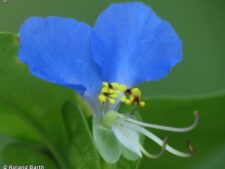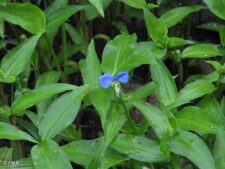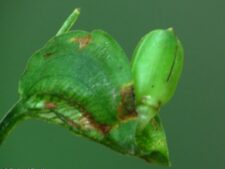
This weedy, naturalized annual was introduced from Asia. This distinctive plant grows in colonies, usually on upright branches from reclining stems. The flowers have three petals, the upper two bright blue and about 1/2 inch across; the lower one, inconspicuous and whitish (A,B,C). At the center of the flower are 4 very visible, but sterile yellow anthers with maroon centers whose apparent function is to attract insects. A closer look will reveal two longer, less visible, fertile, pollen bearing stamens just below with a long white pistil between them (B). The developing fruit is shown in image (D).
Grows in moist ravines and ditches. Often a nuisance in gardens and borders. Flowering plants may be found from June through September. Uncommon in ravines and moist, disturbed areas in Fontenelle Forest and Neale Woods.
Nothing in our area looks like this unusual flower. A related plant, Erect Dayflower (Commelina erecta), is native to the western sandhills of Nebraska but does not extend into our area.
The genus name was given by the famous 18th Century Swedish botanist Linnaeus to honor the three Commelin brothers, two of which were very prominent Dutch botanists. Like the third petal on this flower, the third brother was considered less prominent.
Other common names include Asian Dayflower and Mouse Flower.
The content of NatureSearch is provided by dedicated volunteer Naturalists of Fontenelle Forest who strive to provide the most accurate information available. Contributors of the images retain their copyrights. The point of contact for this page is: Roland Barth.

 Identification
Identification

